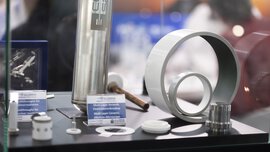Hidden enablers: How technical ceramics are shaping our world
October 28, 2025
When ceramitec opens its doors in Munich from March 24 to 26, 2026, one thing will become particularly clear: Modern high technology and many aspects of daily life—whether at home or at work—would be virtually inconceivable without technical ceramics: They are hidden enablers that we all use in everyday life without being aware of them. Whether it’s in medical technology, electronics, aerospace or the energy transition, ceramic materials are used wherever other materials reach their limits. They combine hardness with precision, temperature resistance with chemical stability, and electrical insulation with high or low thermal conductivity, as required. The exhibiting companies at ceramitec will show exactly what that looks like in practice.
Medical technology—precision in the body
Different standards apply in the human body. Technical ceramics such as zirconium oxide or aluminum oxide are biocompatible, and resistant to wear and corrosion. Thanks to these properties, they are predestined for use as implants, joint prostheses or surgical instruments. A hip joint head made of high-performance ceramics, for example, can withstand millions of movements without showing signs of wear. Ceramic dental implants not only aesthetically match the other teeth but are also metal-free. That makes them the ideal solution for sensitive patients. Ceramic components are also indispensable for bone substitute materials and the smallest components in endoscopic instruments. ceramitec will show how new production processes and materials can further improve the service life and functionality of these components.
Electronics and electrical engineering: hidden performers
They are barely visible, but indispensable: Ceramic substrates and insulators perform key tasks in smartphones, high-performance computers and converters. Aluminum oxide or aluminum nitride ceramics dissipate heat efficiently, while at the same time insulating high electrical currents. They enable miniaturized designs and protect sensitive semiconductors. Ceramics are also the basis for reliability in power and high-frequency electronics—from 5G antennas to inverters in electric vehicles.
Aerospace—materials for extreme conditions
In aerospace, grams and degrees can make the difference between success or failure. Silicon carbide or zirconium oxide ceramics, for example, can withstand temperatures of over 1,500°C without losing their shape. They protect engines, nozzles and sensors from heat and erosion. Satellites use ceramic components, for example, based on cordierite, in housings, mirrors and for thermal insulation. Precision and stability must be guaranteed there over many years, even with constant temperature changes.
Industrial applications and electric heating technology—robust in continuous use.
Extreme conditions often prevail in industrial processes: high temperatures, rapid temperature changes, aggressive media and abrasive particles. Technical ceramics withstand these stresses, whether as nozzles, bearings, valve components, sliding surfaces, or as indispensable components of heating elements. In electrical heating technology, for example, ceramic heating conductors and insulators ensure precise temperature control, whether in 3D printers, furnace systems or the glass industry. Their durability reduces downtimes and maintenance costs, which is crucial for sustainable production.
Renewable energies, battery and storage systems—progress through material innovation
Ceramics play a key role in the energy transition. In fuel cells they serve as electrolyte and separating layer, in batteries as separator or solid electrolyte. Thanks to their ion transport capability and chemical stability, they enable safe and long-lasting energy storage, which is of central importance for electric mobility and stationary storage solutions. Ceramic components are also indispensable in hydrogen technology: They filter, seal and conduct where metallic materials would fail. They are also key components in electrolyzers and other hydrogen production processes.
Defense technology—protection with minimum weight
Light, hard and resistant: These properties make technical ceramics an ideal material for protective applications. Ceramic composite armor combines high hardness and strength with low weight, thus protecting vehicles and people from ballistic threats. At the same time, ceramic sensors and insulators enable reliable functionality even in extreme environmental conditions.
Automotive—ceramics driving tomorrow’s mobility
Ceramic components can be found in almost every vehicle, for example, in lambda sensors, valve seats, brake systems, catalytic converters in the exhaust tract, or high-voltage components. With the advent of electric mobility, their importance continues to grow. They insulate electric currents, manage heat, and guarantee safety in the battery and drive. Additively manufactured ceramic components also enable completely new designs for lightweight construction and functional integration.
Lifestyle, consumer goods and household appliances—aesthetics meets function
Ceramics are no longer just a technical, but also a lifestyle material. High-strength, color-stable and scratch-resistant ceramics are used in luxury watches, smartphone cases and kitchen knives. In household appliances, ceramic heating and sensor elements provide efficiency and durability, light in the oven, or perfect coffee bean grinding.
Analysis technology—precision in the micrometer range
Ceramic materials are the backbone of precise measurements in laboratories and testing systems. They offer dimensional stability, chemical inertness and excellent electrical properties, making them ideal for sensor housings, carrier plates or microfluidic systems. And even the crucible or furnace used daily in the laboratory are also based on technical ceramics. Whether it’s in environmental analysis, medical research or process monitoring, ceramic components ensure reproducible and reliable results.
Ceramics as an enabler of modern technologies
ceramitec 2026 will show that technical ceramics are much more than just a material. Due to their diverse, customized properties, they are a key element in modern technologies and sustainable solutions. From powder technology and additive manufacturing to finished components, the entire range of industrial applications for technical ceramics will be on show in Munich.
Downloads
529743
Belonging images



- PR Manager
